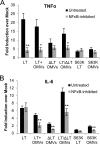Context-dependent activation kinetics elicited by soluble versus outer membrane vesicle-associated heat-labile enterotoxin
- PMID: 21708992
- PMCID: PMC3165487
- DOI: 10.1128/IAI.05336-11
Context-dependent activation kinetics elicited by soluble versus outer membrane vesicle-associated heat-labile enterotoxin
Abstract
Enterotoxigenic Escherichia coli (ETEC) is the leading cause of traveler's diarrhea and children's diarrhea worldwide. Among its virulence factors, ETEC produces heat-labile enterotoxin (LT). Most secreted LT is associated with outer membrane vesicles that are rich in lipopolysaccharide. The majority of prior studies have focused on soluble LT purified from ETEC periplasm. We investigated the hypothesis that the extracellular vesicle context of toxin presentation might be important in eliciting immune responses. We compared the polarized epithelial cell responses to apically applied soluble LT and LT-containing vesicles (LT(+) vesicles) as well as controls using a catalytically inactive mutant of LT and vesicles lacking LT. Although vesicle treatments with no or catalytically inactive LT induced a modest amount of interleukin-6 (IL-6), samples containing catalytically active LT elicited higher levels. A combination of soluble LT and LT-deficient vesicles induced significantly higher IL-6 levels than either LT or LT(+) vesicles alone. The responses to LT(+) vesicles were found to be independent of the canonical LT pathway, because the inhibition of cyclic AMP response element (CRE)-binding protein (CREB) phosphorylation did not lead to a decrease in cytokine gene expression levels. Furthermore, soluble LT caused earlier phosphorylation of CREB and activation of CRE compared with LT(+) vesicles. Soluble LT also led to the activation of activator protein 1, whereas LT(+) vesicle IL-6 responses appeared to be mediated by NF-κB. In summary, the results demonstrate that soluble LT and vesicle-bound LT elicit ultimately similar cytokine responses through distinct different activation pathways.
Figures






Similar articles
-
Heat-labile enterotoxin-induced activation of NF-κB and MAPK pathways in intestinal epithelial cells impacts enterotoxigenic Escherichia coli (ETEC) adherence.Cell Microbiol. 2012 Aug;14(8):1231-41. doi: 10.1111/j.1462-5822.2012.01793.x. Epub 2012 Apr 16. Cell Microbiol. 2012. PMID: 22452361 Free PMC article.
-
Porcine Enterotoxigenic Escherichia coli Strains Differ in Their Capacity To Secrete Enterotoxins through Varying YghG Levels.Appl Environ Microbiol. 2020 Nov 24;86(24):e00523-20. doi: 10.1128/AEM.00523-20. Print 2020 Nov 24. Appl Environ Microbiol. 2020. PMID: 32561576 Free PMC article.
-
Enterotoxigenic Escherichia coli vesicles target toxin delivery into mammalian cells.EMBO J. 2004 Nov 24;23(23):4538-49. doi: 10.1038/sj.emboj.7600471. Epub 2004 Nov 18. EMBO J. 2004. PMID: 15549136 Free PMC article.
-
Review of Newly Identified Functions Associated With the Heat-Labile Toxin of Enterotoxigenic Escherichia coli.Front Cell Infect Microbiol. 2019 Aug 13;9:292. doi: 10.3389/fcimb.2019.00292. eCollection 2019. Front Cell Infect Microbiol. 2019. PMID: 31456954 Free PMC article. Review.
-
Heat-labile enterotoxin: beyond G(m1) binding.Toxins (Basel). 2010 Jun;2(6):1445-70. doi: 10.3390/toxins2061445. Epub 2010 Jun 14. Toxins (Basel). 2010. PMID: 22069646 Free PMC article. Review.
Cited by
-
Pathogenic Lifestyles of E. coli Pathotypes in a Standardized Epithelial Cell Model Influence Inflammatory Signaling Pathways and Cytokines Secretion.Front Cell Infect Microbiol. 2016 Oct 7;6:120. doi: 10.3389/fcimb.2016.00120. eCollection 2016. Front Cell Infect Microbiol. 2016. PMID: 27774437 Free PMC article.
-
Targeting Enterotoxins: Advancing Vaccine Development for Enterotoxigenic Escherichia coli ETEC.Toxins (Basel). 2025 Feb 6;17(2):71. doi: 10.3390/toxins17020071. Toxins (Basel). 2025. PMID: 39998088 Free PMC article. Review.
-
Genome-Wide Assessment of Outer Membrane Vesicle Production in Escherichia coli.PLoS One. 2015 Sep 25;10(9):e0139200. doi: 10.1371/journal.pone.0139200. eCollection 2015. PLoS One. 2015. PMID: 26406465 Free PMC article.
-
Production of extracellular vesicles with light-induced proton pump activity by proteorhodopsin-containing marine bacteria.Microbiologyopen. 2019 Aug;8(8):e00808. doi: 10.1002/mbo3.808. Epub 2019 Feb 22. Microbiologyopen. 2019. PMID: 30793504 Free PMC article.
-
Protein selection and export via outer membrane vesicles.Biochim Biophys Acta. 2014 Aug;1843(8):1612-9. doi: 10.1016/j.bbamcr.2013.12.011. Epub 2013 Dec 24. Biochim Biophys Acta. 2014. PMID: 24370777 Free PMC article. Review.
References
-
- Artis D. 2008. Epithelial-cell recognition of commensal bacteria and maintenance of immune homeostasis in the gut. Nat. Rev. Immunol. 8:411–420 - PubMed
-
- Ashwell J. D. 2006. The many paths to p38 mitogen-activated protein kinase activation in the immune system. Nat. Rev. Immunol. 6:532–540 - PubMed
-
- Black R. 1990. Epidemiology of travelers' diarrhea and relative importance of various pathogens. Rev. Infect. Dis. 12:S73–S79 - PubMed
-
- Cheng E., Cardenas L., Clements J. D. 1999. The role of cAMP in mucosal adjuvanticity of Escherichia coli heat-labile enterotoxin (LT). Vaccine 18:38–49 - PubMed
Publication types
MeSH terms
Substances
Grants and funding
LinkOut - more resources
Full Text Sources
Research Materials

